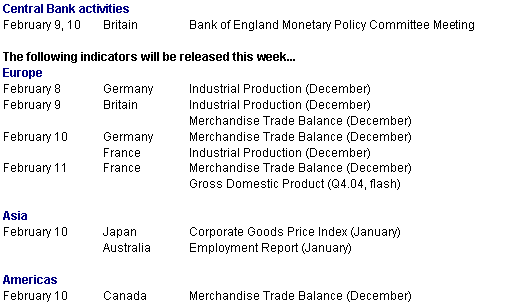Monday, February 7, 2005

Last Week's Highlights
Several events were anticipated during last week as investors awaited the outcomes of the Federal Reserve Open Market Committee and European Central Bank Governing Council meetings on Wednesday and Thursday respectively. Those results were as expected - the FOMC increased their Fed Funds interest rate to 2.5 percent and the ECB left their 2 percent key interest rate unchanged. Neither provided the markets with any unanticipated shocks. Earlier in the week, the Reserve Bank of Australia met for the first time this year and left its interest rate unchanged at 5.25 percent.
On Sunday, January 30th OPEC left its quotas unchanged and deferred action on production levels until its March meeting. But OPEC abandoned the target range of prices - $22 to $28 per barrel - that it set for itself in March 2000. The cartel has not hit that target for 14 months. OPEC maintained that oil prices above $40 or even $50 do not hurt the world economy. As evidence, they pointed to the fact that oil prices rose by 30 percent last year at the same time that the world economy grew by about 5 percent.
G-7 meet, currency stance is unchanged
The Group of Seven finance ministers and central bankers met in London on Friday and Saturday. The statement issued upon the completion of the meetings - at least where it concerned currencies - was identical to that issued a year ago in Boca Raton, Florida. Chinese officials, invited to some of the talks, gave no sign they are poised to change their dollar currency peg. The statement included the promise to monitor currency markets and reiterated that exchange rates should reflect economic fundamentals. They emphasized that excess volatility and disorderly market movements are undesirable for economic growth. Obviously aiming at China, G-7 reiterated its call for the end of pegged exchange rates, emphasizing that more flexibility in exchange rates is desirable for major countries or economic areas that lack such flexibility to promote smooth and widespread adjustments in the international financial system, based on market mechanisms. Chinese officials preempted the G-7's appeal by pledging steps toward a more flexible exchange rate without setting a timetable. Chinese central bank Governor Zhou Xiaochuan said in an interview that it was not yet the time to change the peg,
Business as usual
Federal Reserve
The Federal Reserve Open Market Committee's measured 25-basis-point increases continued and their statement indicated there would be more to come. Market response was a big yawn - the move had been well advertised and there were no surprises in the action or in the accompanying statement. The Fed Funds rate is now 2.5 percent, on a par with the Bank of Canada's policy rate and 50 basis points above the ECB's 2 percent rate.

Reserve Bank of Australia
The Reserve Bank of Australia left its interest rate unchanged at 5.25 percent for a 14th month amid signs of a slowdown in consumer spending and home building. Governor Ian Macfarlane and his eight board members last increased borrowing costs in November and December of 2003. The Australian dollar gained prior to the meeting after inflation accelerated and the unemployment rate fell to 5.1 percent - a 28-year low. But analysts say the RBA will wait for signs that wages and exports are increasing before starting another round of rate increases. The Bank, which doesn't explain its decision when rates are kept unchanged, will release its quarterly statement on the economy on February 7th, and Governor Macfarlane will answer questions before a parliamentary committee on February 18th. The RBA will be watching for signs that inflation is stoking wage increases. The Bank has an inflation target of 2.5 percent.
The Reserve Bank of Australia will probably increase interest rates about 50 basis points during 2005 to curb household and business borrowing according to the Organization for Economic Cooperation and Development. The Australian economy, which has expanded for 13 years, is expected to grow 3.8 percent this year and 3.6 percent in 2006. Those forecasts were unchanged from the OECD's December global economic outlook. The RBA increased borrowing costs twice in 2003 to cut housing demand, which had driven up home prices and debt. Higher oil prices that boost inflation and dampen growth, volatility in the Australian currency, and a more severe slump in the housing market are the main risks facing Australia's economy, the OECD said.
European Central Bank
The European Central Bank once again kept its policy interest rate at 2 percent. Comments by ECB President Jean-Claude Trichet at his post-meeting press conference made clear the central bank is firmly on hold for the near future, but he nevertheless continued to develop arguments for a future rate increase. In his statement, he said much of the same things that were said at the January 13th press conference. The ECB Governing council's assessment of the outlook for medium-term price stability was "unchanged," and the governing council was in exactly the same state of mind as three weeks ago. But Trichet did say that money supply and credit growth were a growing concern and he tied these developments to very low interest rates. He also said that "conditions are in place for economic growth to pick up and become more self-sustained in the course of the year."
Global Markets
It looks as though investors enjoyed the traditional January rally early - in December. The late surge turned 2004 from a dull year into a decent one for equities, and investors decided to take profits as 2005 began. The January surprise was the dollar's rally against the euro. It gained about 4 percent despite very bearish sentiment. The economic data for the month were fairly mixed and did not give any decisive clues as to future growth. The fourth-quarter earnings season has reflected how well companies did in 2004, but at the same time it showed the need for a little more caution as to prospects for 2005. There was little reaction in the equities markets to a lower-than-expected U.S. employment gain of only 146,000 - the unemployment rate did drop though to 5.2 percent. On the week, all indexes with the exception of the Hang Seng were higher.
Global Stock Market Recap

Europe and Britain
The FTSE 100 breached the 4,900 level Tuesday to hit a new 31-month high, boosted by a swell of takeover speculation. The index remained above that level even though it lost ground Thursday primarily because Shell once again reduced its oil reserves numbers. Shell's stock fell after the oil company warned that it had only replaced between 15 percent and 25 percent of the oil it pulled from the ground in 2004. It also said it might look at acquisitions to plug the gap in its reserves. Although Shell reported record British corporate profits and said it would resume its share buyback program, there were worries that the company would struggle to match its record figures.

Like the FTSE, the CAC and DAX took the Fed rate increase and disappointing employment report in stride and continued to rise thanks to favorable earnings, prospective merger activity, relief over the Iraq elections and some surprisingly good economic data from Germany where manufacturing orders soared even as retail sales sank. On the week, all three indexes were up.

Asia/Pacific
Stocks were up in the face of several important international events including the FOMC meeting in addition to the continuing flow of earnings reports. The exception was the Hang Seng, which suffers when the U.S. raises its interest rates. Higher rates are immediately passed onto Hong Kong. The Hong Kong dollar is pegged to the U.S. dollar and U.S. monetary policy is implemented there.

Japanese stocks ended the week on a down note mostly attributed to a newspaper report that Sumitomo Mitsui Financial Group may post a full year loss because of bad loan provisions. The bank was lagging in terms of bad loan write-offs, and some investors are concerned about similar problems cropping up at other banks. The lender denied the reports. However, both the Nikkei and Topix managed to hold onto gains posted earlier in the week.
Australia's all ordinaries continued their climb into record territory while South Korea's Kospi rose for a fourth week. Hyundai Motor, the country's biggest automaker, said it would spend 651.2 billion won ($634 million) to buy back 11 million common shares and 1 million preferred shares between February 11th and May 6th. The company forecast 2005 sales to climb 12 percent to a record.
Currencies
The U.S. dollar staged a rally on Friday, casting aside earlier reticence as investors awaited the outcome of the weekend's Group of Seven meeting in London. The G-7 was somewhat upstaged as Fed Chairman Alan Greenspan spoke about the U.S. current account deficit at a London conference. Currency traders were edgy prior to his talk lest he trigger a sell off with negative comments on the current account deficit. But he didn't and a dollar rally, especially against the euro, took hold. In his remarks Greenspan said that market pressures may help to narrow the deficit.

Just before the Greenspan speech, U.S. employment situation report was released. The dollar fell against the euro and yen after the Bureau of Labor Statistics said the U.S. economy created only 146,000 jobs in January, fewer than the median forecast of 200,000. The dollar reversed direction.
The yen declined on the week on speculation the G-7 statement will ignore French and German calls for Asian countries to strengthen their currencies. Japanese Finance Minister Sadakazu Tanigaki does not expect policy makers to say anything new on currencies over the weekend.

The Canadian dollar fell after the Federal Reserve raised its target interest rate and erased Canada's rate premium over the U.S. for the first time since April 2001. The Canadian dollar is feeling the impact of interest rate differentials which are moving in favor of the United States. Canadian exports have been hurting because of the relatively high value of the currency. About 40 percent of the Canadian economy is tied to exports, which cost more abroad when the Canadian dollar appreciates. Canada's dollar surged 19 percent from mid-May to late November when it reached a 12-year high of US$0.8532. The Bank of Canada noted in a recent monetary-policy update it would raise rates at a pace "likely to be slower than envisioned." The FOMC reiterated it would raise interest rates "at a pace that is likely to be measured."

The Russian central bank said Friday that as of February 1st it had switched to a dual currency basket, loosely pegging the ruble against both the euro and dollar, rather than just the dollar. The immediate effect of the decision on the composition of Russia's $128 billion of gold and foreign exchange reserves was unclear. The euro's weighting in the currency basket will initially be 10 percent, although this will increase "to a level that corresponds to tasks of the exchange rate." Some 65 percent of Russia's trade is currently conducted with the eurozone, suggesting this higher level may be the eventual weighting of the euro in the ruble's basket.
Indicator scoreboard
EMU - January seasonally adjusted manufacturing purchasing managers' index edged up to 51.9 from 51.4 in December. Boosting the PMI was a further acceleration in the rate of growth of manufacturing output from the 15-month low recorded in November. The output index indicated the fastest growth since October. For the sixth month running, the strongest growth of output was recorded in France, where the rate of increase picked up for the second month in a row. An index reading above 50 signifies growth.

January seasonally adjusted services purchasing managers' index climbed to 53.4 from 52.6 in December. All major countries improved on their December readings. The improvement came from the consumer side, especially in France and Germany, while industry orders to the services sector remained below previous-year levels. The eurozone composite index which combines the manufacturing and services index rose to 53.4 from 52.5 in December.

December seasonally adjusted unemployment rate was 8.9 percent, up from the revised November reading of 8.8 percent. Of the nine countries reporting data, unemployment was up in two, down in two and unchanged in the remainder. Spain continued to show the highest unemployment rate of 10.4 percent, followed by Germany at 10 percent and France at 9.7 percent. Ireland recorded the lowest rate at 4.3 percent followed by Luxembourg at 4.3 percent and Austria at 4.5 percent. Eurostat estimated that 12.6 million men and women were unemployed in the eurozone.

December producer price index was down 0.2 percent but up 3.6 percent when compared with last year. The monthly decline was due to a drop in energy prices. Energy prices declined 1.5 percent after dropping 1.3 percent in the previous month. Excluding energy the PPI was up 0.2 percent and 2.9 percent on the year. Only nondurable consumer prices increased while others were flat to down on the month.

January flash harmonized index of consumer prices was up 2.1 percent when compared with last year. Eurostat does not provide details for the flash report. The ECB's inflation ceiling is 2 percent.

December real workday-, inflation- and seasonally adjusted retail sales were up 0.2 percent and 0.5 percent when compared with last year. Food, drink & tobacco sales were up 0.2 percent while non-food sales were up 0.4 percent. Only five eurozone countries reported December retail sales data - Belgium was up 0.7 percent, France was up 0.5 percent, Portugal was up 1.8 percent, Spanish sales were unchanged and German sales were down 0.3 percent.

EU - January economic sentiment inched up to 100.6 from 100.2 in December. Industrial sentiment weakened to minus 5 from minus 4 in the previous month. The decline was due to deteriorating production expectations offsetting a slightly more positive outlook on orders. Consumer sentiment remained unchanged at minus 13 with most components also remaining unchanged. Sentiment improved in services and retail trade but declined in construction.

Germany - December seasonally adjusted total retail sales dropped 1.2 percent and were down 2.4 percent when compared with last year. Excluding autos and gasoline stations, retail sales were down 0.3 percent and down 2.7 percent on the year.
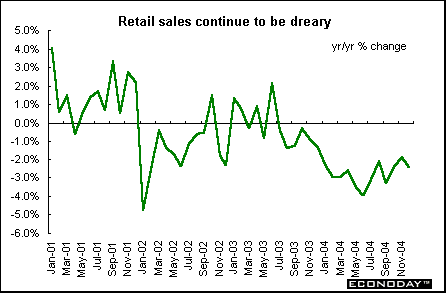
January unemployment rate jumped to 11.4 percent from 10.8 in December. West German unemployment rate jumped to 9.3 percent from 8.7 in the prior month while in east Germany, the unemployment rate soared to 19.2 percent from 18.8 percent. The seasonally adjusted number of people out of work was up by 227,000 to 4.71 million including 230,000 new jobless claimants. The jump to the highest level since World War II occurred as new rules added welfare recipients to the jobless rolls. German jobless statistics now include all recipients of what is known as unemployment benefit II, paid to those without a job for more than a year as well as people such as single mothers and low wage-earners who used to receive social-welfare payments and did not have to register at job centers. All those on the new benefit program who can work at least three hours a day are counted as jobseekers and face benefit cuts if they reject job offers.
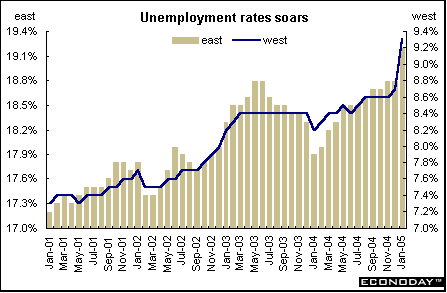
December real seasonally manufacturing orders soared upward by 7.1 percent both on a monthly basis and when compared with the previous year. Orders were strong across the board, but above average bulk capital goods orders were primarily responsible for the huge increase. Domestic orders jumped 8.8 percent while foreign orders were up 5.3 percent. Investment goods orders soared 12.8 percent, more than offsetting November's 4.4 percent drop. Consumer goods orders were up 1.8 percent after gaining 2.8 percent in the previous month. West German orders were up 8.1 percent after sinking 2.5 percent in November while east German orders dropped 4.7 percent after declining 2 percent in the prior month.
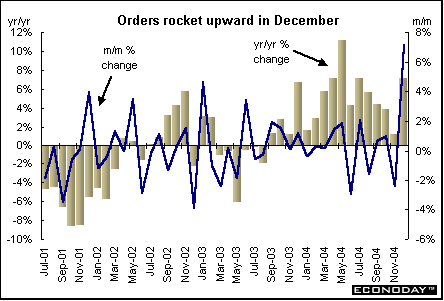
Italy - December producer price index was down 0.2 percent but was up 4.2 percent when compared with last year. Prices were down for energy, primarily due to a 2.6 percent drop in refined gasoline products. Intermediate and capital goods were flat, while consumer goods rose. Five of the 18 product categories were down on the month.
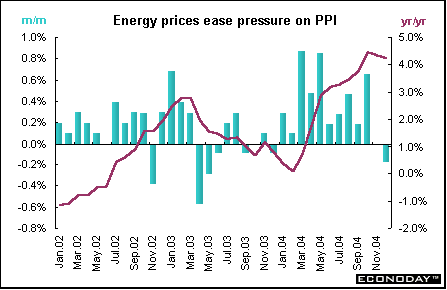
Britain - January Halifax house price index was up 0.8 percent and was up 12.6 percent when compared with the same month last year. The average price of a home rose 0.8 percent to �163,748 ($308,443) after a revised 1.4 percent gain the previous month.

Asia
Australia - December merchandise trade deficit narrowed to A$2.37 billion ($1.8 billion) from A$2.66 billion in November. Coal, metals and machinery exports gained while imports declined from a record. Exports were up 1.2 percent while imports dropped 0.9 percent. Exports of rural goods, such as meat, wheat and wool, dropped 3 percent but exports of non-rural goods, such as iron ore, fuel and manufactured items, gained 3 percent. Consumer goods imports dropped 1 percent and capital goods imports including business machinery, was down 2 percent from November. Intermediate goods imports, which include oil and spare parts, declined 2 percent.
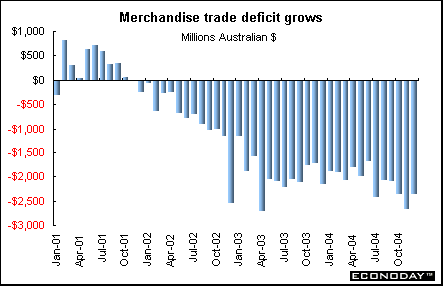
December retail sales in December dropped 0.3 percent but were up 2.1 percent when compared with last year. This was the third consecutive month of declining sales. Department store sales were down 1.8 percent while restaurants were down 1 percent. However recreational goods sales were up 1.4 percent.
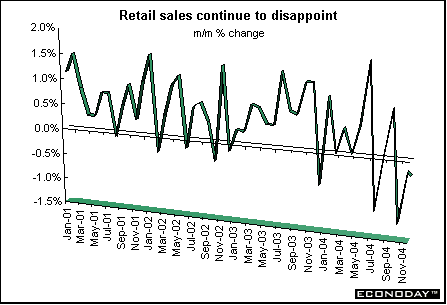
Americas
Canada - November monthly gross domestic product was up 0.2 percent and 3. 1 percent when compared with last year. Wholesaling services boosted by higher demand for machinery and electronic equipment as well as oil & gas exploration spurred by high energy prices contributed to the increase. Output was higher in 13 of the 21 major groups.
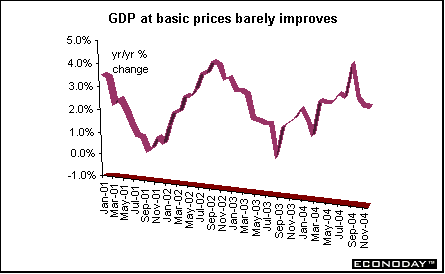
January unemployment rate remained at 7 percent for the second month but employment was down by 5,700 jobs. The decline was mostly in part-time work. Manufacturing employment was up by 14,000 while retail and wholesale employment gained 18,000 jobs. Construction jobs were up by 10,300. The participation rate was 67.4 percent.
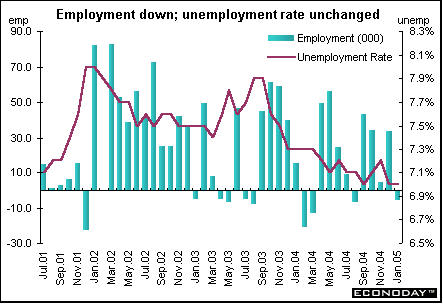
Bottom line
After a week of important events and the avalanche of new economic data, investors will have a chance during this relatively quiet week to reevaluate and digest the information. Many Asians will be welcoming the year of the rooster and many markets will be closed during the week. Elsewhere, the Bank of England Monetary Policy Committee will be meeting Wednesday and Thursday. They are expected to keep their policy interest rate at its current 4.75 percent.
Looking Ahead: February 7 through February 11, 2005
